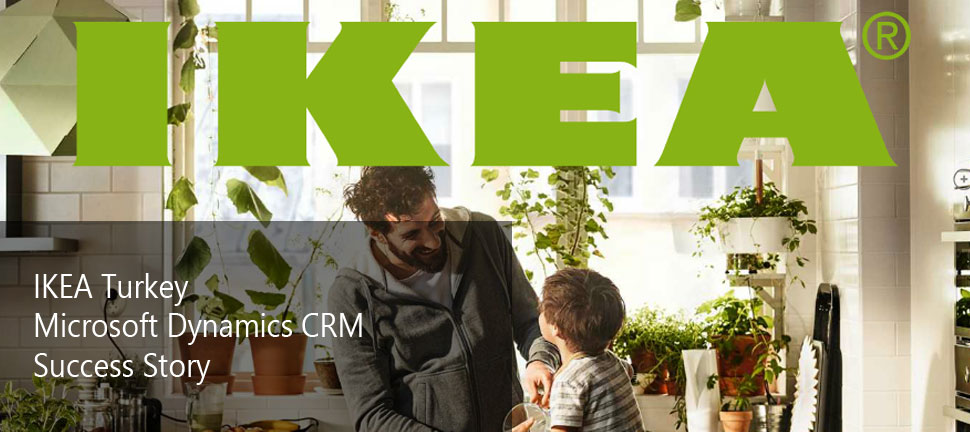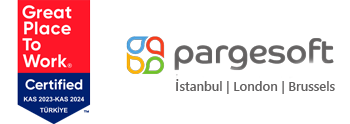IKEA Turkey is using Microsoft Dynamics CRM for IKEA Family Card infrastructure, a loyalty program which it will activate in near future.
However, IKEA takes advantage of the flexible structure of Microsoft Dynamics CRM so that no additional labour is created and customers do not experience additional waiting times both when signing up and shopping. The card application form filled by the customers and containing the minimum information is entered into the CRM. It creates the CRM card number and status and transfers it to the POS application immediately. Thus, the systems are ready as soon as the form is filled. As the shopping is processed by the POS, the shopping details first go to Microsoft Dynamics NAV, where the promotion rules are checked, and then the earned points are sent to the CRM. In this way, both ERP systems and CRM contain all the necessary information. Reports can be produced from different perspectives so that employees with different responsibilities can perform comprehensive analysis.

Commercial Status
Opening stores with the franchise system throughout the world, IKEA is entering into business partnership with MAPA Mobilya ve Aksesuar Pazarlama A.Ş., the main shareholder of which is Maya Holding A.Ş. In Turkey.
Aiming to reach as many people as possible by offering thousands of beautifully designed, high quality and useful furniture and home accessories at low prices with the vision of a better daily life for the majority, the first store of IKEA Turkey was opened on May 5, 2005 in Ümraniye, Istanbul.
Having achieved great success after the opening of its first store, IKEA Turkey opened its second store on 6 April 2006 in Bornova, İzmir.
Turkey’s third and Istanbul’s second IKEA store was opened in Bayrampaşa on 8 November 2007. IKEA Turkey increased the interest in home decoration and on November 13, 2008, its 4th store was opened in Bursa Osmangazi. IKEA Ankara Store, the biggest store of IKEA, which is a brand that shows how home life can become enjoyable with creative decoration solutions in small square meters, was opened on 23 June 2011.
With family card application, IKEA aimed to offer more value by constantly providing its customers with rewards and privileges. While putting this application into use, Microsoft Dynamics CRM commissioned a solution that would be easily integrated with existing systems, would not cause customers to spend additional time both in membership and shopping processes, and that would allow evaluations from different perspectives.
Swedish-based international furniture company IKEA, which started to serve in Turkey with the store it opened in Ümraniye, Istanbul in May 2005, decided to start a loyalty program for the strategy of selling more products to the same customer.
Ayşe Gedikli, Marketing Department CRM and Research Manager states Ayşe Gedikli stated that, by aiming all customers who visit IKEA stores to have IKEA Family Card instantly and free of charge, to shop with opportunities at IKEA stores, they offer the opportunity to benefit from seasonal campaigns as well as gift points and special product discounts earned with every shopping.
The IKEA Family Card Marriage Campaign, which is special campaign intended for couples getting married, is a good example of this. On the other hand, IKEA Family Card, taking into account the common needs of families, brings together the shopping of all members of a family in a single card and launches different promotions for these families.
How did the collaboration start?
Information Technology Manager Bülent Erkmen stated that they evaluated different alternatives in order to implement this application quickly and smoothly without prolonging the time spent at the cash register, and that the most important criterion is to have the competencies to be easily integrated with the existing ERP system, not to extend the time spent at the cash register, and to meet the needs of the marketing department. Erkmen said: “Of course, one of the important issues in the long run was the system’s performance in analysis and reporting as the quantity of data in the system increased.“ When all alternatives were examined, Microsoft Dynamics CRM came to the fore as the most suitable solution. In addition to the ease of application development and its infrastructure that is very suitable for integration, the analysis options that are facilitated and accelerated by SQL Reporting Services and Business Intelligence applications have reinforced the belief that CRM will be the best solution in the medium and long term.
After the pilot application started in Ümraniye store in November 2009, all stores were commissioned in December. All transactions, such as issuing cards to applicants instantly, tracking the purchases of cardholders, identifying promotional products, and transferring the relevant prices to POS devices, started to be put into use smoothly through the system. In the first months of the launch period, the target number of cards was achieved. Currently, 150,000 cards are in use. Since the targeted number of members has been reached, efforts have already been accelerated to increase the number of members and the average shopping amount of the members with the data accumulated in the system from now on.
What benefits have been achieved with Dynamics?
Savings in Indirect Labour – In a loyalty card application, identifying members, entering relevant information into the system, collecting later purchases as points on the card, and using these points in some discounts and promotions brings along additional labour. However, IKEA takes advantage of the flexible structure of Microsoft Dynamics CRM so that no additional labour is created and customers do not experience additional waiting times both when signing up and shopping. The card application form filled by the customers and containing the minimum information is entered into the CRM. It creates the CRM card number and status and transfers it to the POS application immediately. Thus, the systems are ready as soon as the form is filled. As the shopping is processed by the POS, the shopping details first go to Microsoft Dynamics NAV, where the promotion rules are checked, and then the earned points are sent to the CRM. In this way, both ERP systems and CRM contain all the necessary information. Reports can be produced from different perspectives so that employees with different responsibilities can perform comprehensive analysis.
Customer profiling
The biggest expectation from the IKEA Family Card application is to get to know the customers. Being able to design different campaigns that will encourage them to visit the store more after getting to know the customers. IKEA uses life cycle for customer profiling internally. The stage of IKEA customers is determined based on the information accumulated in Microsoft Dynamics CRM. Campaign content is created for the customer in accordance with the needs of this stage. In this way, more returns are achieved in campaigns, the number of customers and the average quantity of shopping carts increase.
When all information is in a single system, IKEA can also measure the effectiveness of its campaigns. While the campaign is being designed, they can see which customers will be addressed, the size of the target audience, and the average shopping cart amount of this target audience. After the campaign starts, those who visit the store and shop from within this target audience can be reported. For each campaign, the change in the average shopping amount and the total effect of the campaign within this change can be observed. In addition to this, discounts can be added separately for constantly changing products. In such product-specific campaigns, the effects in terms of the product can also be easily observed.
Due to the integration of the systems, the expected increase in the sales of the products that will enter the campaign is transferred to the supply chain planning, and the necessary products are supplied in this way The company aims to design more detailed campaign models in future. For example, it is aimed to offer lighting products to the customer group that purchased living room furniture in the past months, increase the number of such campaigns and to measure the flexibility of demand with similar campaigns in the future.

